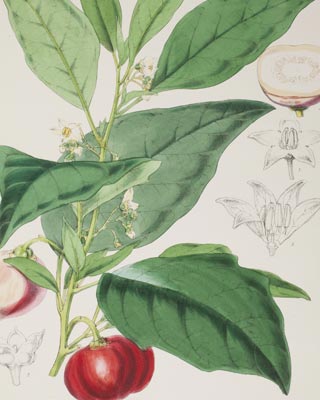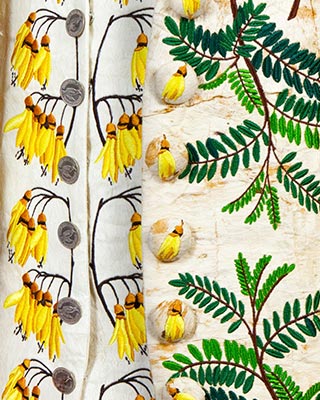Both Flora Vitiensis and Jo Torr’s Pacific Crossings pay tribute to the meticulous work of botanists during the historic exploration of the Pacific. These works encapsulate the value long placed upon flora as a resource in science, medicine, artistic endeavour and in everyday life. They demonstrate changes that occurred following interaction between European and Pacific people and the ways in which flora was and can be used. The result of Seemann’s and Torr’s works is a seamless fusion of art and science, which reveals their passion and dedication to their chosen fields.

From the Flowers of Fiji to Pacific Textiles
Berthold Seemann, born in Hannover but trained at Kew Gardens, accompanied a nineteenth century British expedition to assess the viability of growing cotton in Fiji. Seemann seized the opportunity this provided to explore the region’s flora. In the absence of government funding, he then undertook a variety of unlikely jobs – including managing a goldmine in Nicaragua – to ensure the publication of his findings. Although he did not live to see the project completed, the resulting volume is remarkable for the nearly 100 extraordinary lithographs by W R Fitch. This one depicts what is probably a large-fruited form of the species Solanum viride (whose tomato-like fruit was used at cannibal feasts). The University of Canterbury's copy was donated by the Hawke’s Bay branch of the Royal Society of New Zealand.

'Solunum anthropophagorum' now thought to be Solanum viride Berthold Seemann, Flora Vitiensis: A description of the plants of the Viti or Fiji islands, with an account of their history, uses, and properties (London: Reeve & Co, 1865-73) University of Canterbury Library

Pacific Crossings by Jo Torr, designed and made in 2006. Canterbury Museum, 2007.130.1
Created by contemporary textile artist Jo Torr, Pacific Crossings consists of a wearable and sculptural coat and waistcoat. They are intricately designed and reminiscent of both twenty-first and eighteenth-century style garments. Both coat and waistcoat are made of tapa/barkcloth, lined with calico, and the waistcoat includes buttons made from 1957 New Zealand sixpences. Pacific Crossings was inspired by the discovery of a fragment of tapa. Supposedly, Captain James Cook’s wife, Elizabeth, had begun to embroider this piece of tapa and shape it into a waistcoat. The hand embroidered flowers and leaves of the New Zealand kowhai are inspired by the paintings Sydney Parkinson made from the botanical specimens collected by Joseph Banks and Daniel Solander on Cook's first voyage to New Zealand in 1769.
Want to know more?
W. R. Sykes, 'Berthold Seeman & his Flora Vitiensis', in Treasures of the University of Canterbury Library, ed. by Chris Jones & Bronwyn Matthews with Jennifer Clement (Christchurch: CUP, 2011)